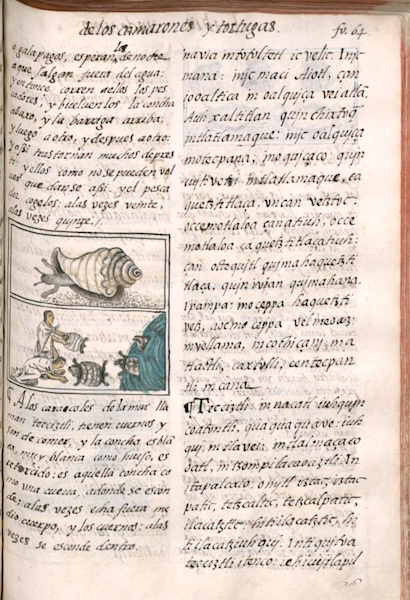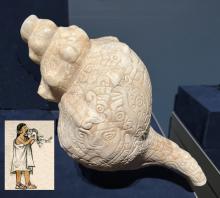tecciztli (FCbk11f64r)
This iconographic example of a conch shell (tecciztli) is shown lying on its side on a granulated surface intended to resemble sand. The shell is beautifully drawn in black in profile with a segmented body. On its extreme right the shell comes to an end with a characteristic swirling tip, while the other end is the opening from which the mollusk or soft-bodied sea snail emerges. This is a gray-colored figure with two antennae with two eyes below them. Unexpectedly, the snail has two human-like arms, as well. The foot of the snail can be seen protruding below the shell.
Robert Haskett
Conch shells were important in both the mundane and ritual life of the Nahuas. They were cut to display their spiraled interiors and worn as pectorals, among other things, associated with the supernatural force known as Ehecatl-Quetzalcoatl (wind-feathered serpent) (see other tecciztli entries in this Visual Lexicon). Book 11 of the Florentine Codex describes the living conch shell in the parallel Spanish text as something to eat. In the Nahuatl text, its "flesh is like a small snake; it has horns like something large…. Its shell is a white bone—very white; smooth—very smooth; spiral—spiral within…. What we speak of as at the lips of the snail shell is at its tail. What we say has become its tail has become its mouth. From there it comes out; there it enters. As it enters, it only retreats.” The tecciztli was also used as a trumpet, described as being “white…. It is spiraled, marvelous. It is that which can be blown, which resounds.” (Quotes from Anderson and Dibble, 60, 230.). There are many references to the use of conch shell trumpets in ritual settings found the Florentine Codex, Book 2, The Ceremonies. During the "second month, which was called Tlacaxipeualiztli," the reader is told "the trumpets were sounded, conch shells, large sea shells, were blown, men put their fingers in their mouths and whistled, and there was singing. With singing and songs and blowing of trumpets they arrived. The Cozcateca placed themselves in order, their shoulders decked with feather banners, and they encircled the offering stone." In the festival of the “sixth month, which was called Etzalqualiztli,” “all went to be bathed. They went sounding trumpets (tecciztli); they went blowing shell trumpets; they beat copper discs with pine [hammers]]” (Quotes from Anderson and Dibble (1951) 46, 50, 74, 77).
Robert Haskett
Tecciztli
tecciztli
Robert Haskett
1577
Robert Haskett
shells, conch shells, conchas, trumpets, trompetas
The photograph of the engraved conch shell trumpet was taken by Robert Haskett at the Museum of Fine Arts, Boston, May 11, 2023. It is identified as dating from between AD 1425-1520. The description observes that it has "a hole drilled through the end of the shell [which] allows it to be strung on a narrow cord, perhaps so it could be suspended around the performer's neck." The image of the man playing a conch shell trumpet is from the Florentine Codex, Book 2, The Ceremonies, folio 127 verso, https://www.loc.gov/resource/gdcwdl.wdl_10613/?sp=254&st=image&r=-0.601,.... Note the way sounds are made visible in this image.
tecciz(tli), conch shell, trumpet, https://nahuatl.wired-humanities.org/content/tecciztli
la concha
Robert Haskett
Library of Congress, General History of the Things of New Spain by Fray Bernardino de Sahagún: The Florentine Codex. Book XI: Natural Things, folio 64 recto, https://www.loc.gov/resource/gdcwdl.wdl_10622/?sp=129&r=-0.404,0.027,1.8...
The Library of Congress is unaware of any copyright or other restrictions in the World Digital Library Collection. Absent any such restrictions, these materials are free to use and reuse. Researchers are encouraged to review the source information attached to each item. If you do publish anything from this database, please cite the Visual Lexicon of Aztec Hieroglyphs.






